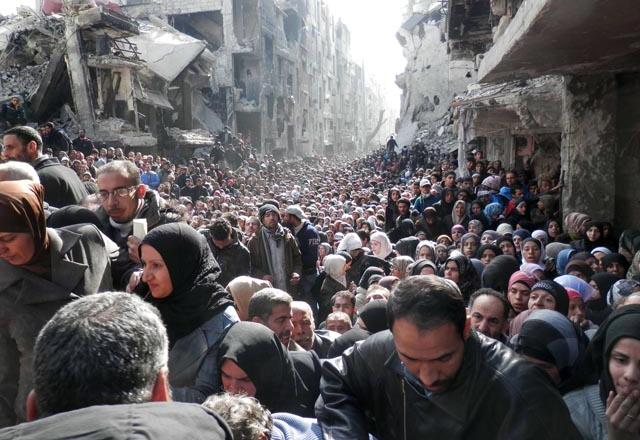You are here
Shortages and deprivation blight Syria after 3 years of war
By AFP - Mar 11,2014 - Last updated at Mar 11,2014

BEIRUT — Some survive by eating animal feed, others are reduced to living off vegetable peel. The human degradation in Syria, notably in areas besieged by the army, has reached levels unimaginable three years ago.
Since the protests against President Bashar Al Assad in March 2011 descended into a bloody civil war, images of Syrian civilians suffering have become commonplace.
Areas such as Yarmouk, Eastern Ghouta and Homs city have become synonymous with dire living conditions and shortages of basic goods, after regime forces besieged them.
Authorities say they blockade the areas to root out “terrorists” — the government’s term for the rebels fighting to overthrow it — but NGOs like Amnesty International accuse them of using starvation as a “weapon of war”.
Delivery of vital aid has also been hindered by groups hostile to international NGOs in parts of rebel-held northeastern Syria, according to the World Food Programme (WFP). The WFP said insecurity in the country had prevented food deliveries reaching 500,000 people.
One of the worst affected areas is the Yarmouk Palestinian refugee camp in southern Damascus.
Once a buzzing neighbourhood that was home to 170,000 people, Yarmouk became a battlefield between rebel and regime forces in 2012, and government troops imposed a choking siege on the area.
Nearly 40,000 Yarmouk residents, both Syrian and Palestinian, are trapped inside, living in abject conditions: Amnesty says at least 60 per cent are malnourished, and a Syrian monitoring group says 120 people have died from hunger and lack of medical care in the camp.
“The lexicon of man’s inhumanity to man has a new word: Yarmouk,” Chris Gunness, spokesman for the UN’s agency for Palestinian refugees UNRWA, told AFP.
He said some people have been “reduced to eating animal feed”, adding women in the camp were “dying in childbirth for lack of medical services”.
The agency released a striking picture showing thousands of residents crammed into a war-scarred street queuing for aid, illustating their desperation.
Amnesty said the Yarmouk siege was “the deadliest of a series of armed blockades of other civilian areas, imposed by Syrian armed forces or armed opposition groups... across the country”.
‘Insult to our dignity’
Sahar, a 56-year-old Yarmouk resident has already paid a heavy price in the conflict in Syria, losing her husband and son in the violence.
But since the government cut the camp off from the outside world, she has lost “20 kilograms”, she told AFP via the Internet, a problem aggravated by her hypoglycemia and osteoporosis.
“The shortages are an insult to our dignity.”
For Sahar and thousands of others like her trapped in the camp, regular meals are a distant memory.
“Days ago, some neighbours managed to bring in aubergines and rice from Babbila,” an area near the camp, she says.
“It was the first time that I have had a meal in months,” she says, choking back tears. “We had almost forgot what ‘cooking’ meant.”
Others in the camp told AFP stories that showed the extent of the degradation of a country that was once self-sufficient for food.
“People are dying at home and the rats eat them before their neighbours can find their bodies,” says Jassem, an activist in Yarmouk.
Since January, UNRWA has distributed nearly 8,000 food parcels in the camp, calling this “a drop in the ocean compared with the rising tide of need”.
Heating ‘a luxury’
And in besieged areas, shortages of medical supplies, fuel, water and electricity are just as pressing.
“Things that were normal before the siege, like television or heating, have become a luxury.” says Tarek, a teacher in the Eastern Ghouta area, which was nicknamed “Damascus’ orchard” before the siege.
“A kilogram of margarine has risen from 50 Syrian pounds to 750 ($0.30 to $5) and a litre of diesel from 20 to 1,700 pounds,” he says over Skype.
Eastern Ghouta residents have resorted to “digging wells, like in the olden times, but the water there is very polluted”, says Tarek, who teaches by candlelight in basements in case of shelling.
The army has also encircled several areas of the central city of Homs, where 1,500 civilians were evacuated by the UN in February.
At the beginning of March, the UN-mandated Commission of Inquiry on the human rights situation in Syria said more than 250,000 people were under siege across the country.
It said government forces and rebels were using the tactic to force “people to choose between starvation and surrender”.
The conflict has already claimed a terrible human toll, with more than 140,000 people killed since the uprising began Another 2.5 million people have fled abroad while 6.5 million have sought refuge inside the country.
More than half of the country’s hospitals have been destroyed and 2.2 million children have been forced out of school in a country that once offered free healthcare and education to all.
Related Articles
Besieged since June, nearly 20,000 people in Damascus’ Yarmouk Palestinian camp are so desperate for food that many eat stray animals and some women have resorted to prostitution, according to residents reached via the Internet.
At least seven civilians died of hunger and lack of medical care in two days in besieged areas around the Syrian capital Damascus, medical sources said on Tuesday.
Two weeks of battles between Syrian rebels and jihadists have killed at least 1,069 people, mostly fighters, the Syrian Observatory for Human Rights said Thursday.
















